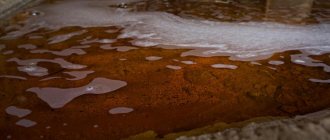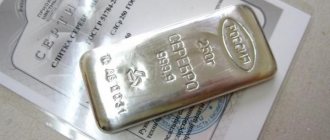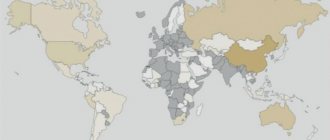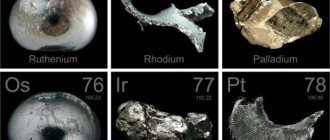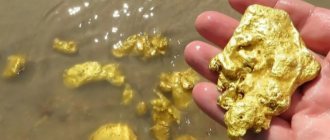Traditional methods of gold mining are simple and incredibly tenacious: to this day, in developing countries in Africa and Latin America, the local population produces precisely these “old-fashioned” methods.
After heavy summer (or winter) rains, there are floods that wash rocks, possibly gold-bearing rocks, into rivers and streams. The gold miner knows how and where to look for it. However, after a couple of weeks, this thin layer can become covered with silt and algae, after which gold mining becomes difficult.
Therefore, a hot time is coming for prospectors; there is no time to waste. The main task: to get a larger volume of rock from the river and wash it almost around the clock, while you have the strength. Prospectors are trying.
The goal is to wash a bag of golden sand, which will settle to the bottom as the heaviest part of the rock. The work requires a lot of effort, you have to work in cold water and only the anticipation of prey keeps you warm.
James Hurst
Gold mines made James Hearst the personification of the American dream: born into a rather poor family, by the end of his life he was able to amass a huge fortune and died one of the richest and most famous people of his time. Contemporaries said that Hirst had a “nose” for wealth-generating veins. The fact that he began mining gold as a boy also helped the future prospector achieve success. Hearst, forced to drop out of school, and his friends helped local miners, and when the gold rush hit California, he was ready for hard work.
Hearst went to the mines in the company of two cousins. At first, luck turned away from the young people: at the end of a year of searching, they had only $40 left for three of them. Then the brothers moved to Grass Valley and there they finally discovered a gold mine that changed their lives. Soon Hearst opened his first mine, which he sold at a profit a couple of years later. Since then, the Californian’s business has been built according to the same pattern: Hirst acquired a potentially profitable plot, found gold on it and resold it for much more.
Gold Hunter, California. (wikimedia.org)
Having become rich, Hearst began investing in real estate, cattle breeding and horse breeding. However, his main source of income remained the mines, not only in California, but also in Utah, Montana and South Dakota. At the time of the tycoon's death, his fortune was estimated at between 200 and 400 thousand dollars.
Where do they look for gold and by what criteria?
Can geology be divided into two areas: the study of minerals and the search for gold?
There is a general section of mineral geology and there is the geology of gold deposits. At one time we had special training in the study of placer geology, but now it is more unified.
Why is gold hard to find? How are they looking for him?
The main problems with finding gold are related to the fact that gold is, firstly, a rare metal, and secondly, precious. There are classifications of metals: ferrous, non-ferrous, rare. Gold falls into the category of precious metals. This classification is a little outdated, but is still used today. The problems with finding gold are due to the fact that it is a rare metal, the gold content in the ore that can be mined is grams per ton, which is 10^-4 of one% or 1 millionth of a part of something. That is, finding these parts per million somewhere is very difficult. Nowadays it is very rare to find deposits, as they show in old films, where a man goes, washes a tray and finds the ores themselves, or as in the film about the “gold rush”, where a man goes alone and a killer sneaks up behind him, this is not so. Now the search for deposits is a serious study, that is, first it is necessary to predict where to look, because geologists are looking for what they themselves, as they say, “did not lose or hide,” they are looking for what nature hid. Accordingly, in order to find it, you need to understand what it looks like and where it could be. Let's say when you lost the keys to your house, we ask the guests to help, the guests will want to know what they look like, so as not to be confused with their own, and where they could be left. Here the situation is a little more complicated, because if we roughly imagine what gold deposits look like, they are either veins, that is, plate-shaped bodies where transparent quartz is located, it is called “rock crystal”. With gold, quartz can be different: white, gray, etc. And these veins, which go deep into the bowels of the earth, are found mainly by samples. In general, it is not even stone that is selected for analysis, but clay, that is, the top layer of soil is removed, where the geologist works not with a hammer, as they show in films, but with an ordinary shovel. Afterwards, a portion of clay is placed in a bag, then a label is placed indicating the sample number, while we use GPS and they follow a certain line, that is, we know where they took this sample, and then in the city or in the field they analyze for certain elements. However, this test is not for gold, because there is very little of it. If there is a gram per ton of it in the ore, there will be much less of it in these samples, literally some traces. And if we have some elements that are satellites of gold in the clay, for example, arsenic or copper, lead, zinc, then there is reason to take an interest in this place in more detail. The expedition comes there again next season, in this place they dig holes, ditches and take samples from the stone that was dug up under this loose material, under the clay. Now, if the rocks there show a high gold content, then it’s already interesting, you can start drilling. A bulldozer is already making a road, a drilling rig is driving and it is possible to extract information from a greater depth. And if we not only found gold in some required content, but we found a certain amount of it (geologists call this “reserve”), let’s say, we calculated and found out that, then the gold content, multiplied by the volumes of rock studied, gives We have, say, 4-5 tons of gold. It’s a small deposit, but then it can be developed.
Can all geological occurrences of gold be called minerals?
If a geologist finds a piece of rock and there are grains of gold in it, this is not yet a deposit. This is scientifically called the “mineralization point.” Such a term. If we have proven that this point of mineralization has some dimensions on the surface, not yet in depth, this is called the word “ore occurrence.” It is assigned, like the mineralization point, its own number, it is indicated where it is located, and all subsequent expeditions that will plan their work in these places will know about this object that it is potentially worthy of study. If we study it properly and it turns out that we have enough ore in terms of quantity and quality to keep the mine operating for 10-15 years, then we can develop it; this is already a deposit with a mineral - gold ore.
Does the economy affect mining?
Economics determines a lot. The development of a deposit depends, for example, on the distance from civilization and vice versa on its proximity. Let's say, now in Sweden the village of Kiruna is moving or has already moved, because it turned out that the field next to which it was built extends under this village itself. And they decided not to leave it all there, but to move. They will probably move some historical buildings and develop them further. There are also disadvantages to being too close to civilization. But here is the opposite example - in the middle of the 20th century in Transbaikalia, in the modern Transbaikal Territory, a unique Udokan (along the Udokan ridge) copper deposit was found. In fact, it is a complex deposit, there is copper and silver and, probably, some gold. But the main component, of course, is copper. It was explored in Soviet times, abandoned during perestroika, and is now being re-prepared for operation. I hope they will start mastering it soon. That's how much time has passed since the opening, despite the fact that from the very beginning it was clear that this was a very large object. When gold ores began to be mined at the beginning of the 20th century, the ore content (in industrial grade) was considered to be higher. That is, back then they extracted gold from ore worse and it was necessary for there to be more gold in the ore. For example, 20-30 grams per ton. It was quite good content. Now, you remember, 2-3 grams per ton, and somewhere around half a gram is good. Thanks to modern technologies, such ores can also be processed. Therefore, it turned out that where they laid the mine and narrowly passed seemingly empty rocks at that time - now this entire surrounding space is quite ore. Therefore, on the site of many mines, including there, there are quarries that mine this once empty rock, now ore.
Can an ordinary person pan for gold on his own? What other minerals can people find?
Theoretically yes. Another thing is that searching for gold without a license is fraught with conflicts with the law. That is, if something is found, it is better to leave it where it was found, so as not to create problems for yourself. For example, you can look for pebbles in the Yenisei. You can find the same quartz there. It can be beautiful: sometimes it is translucent, and sometimes it is completely transparent. Agates can be found on the Kache River. This is quartz, but with a more complex organization - in the form of nodules. These are pebbles, but the chips create beautiful patterns in circles. When you find one, it's Agate.
Another beautiful thing in the Yenisei is that you can often find pebbles of volcanic rocks that the Yenisei brings from the Sayan Mountains. They are usually different shades of green. They contain white inclusions - white feldspar crystals. Such volcanic rocks are quite strong, so they take a long time to round. The Yenisei picked them up somewhere hundreds of kilometers upstream, and they reached us.
Gold is unlikely. If only for the simple reason that it sank somewhere deep. In small rivers, where there is a rocky base nearby - a raft, this is possible. Geologists call the waste rock that sits above a placer, such as pebbles, sand, clay, “peat” with the emphasis on the last syllable. Then, when they reach a mineral deposit, an area where there is gold or diamonds, this is called sand or formation. And if, finally, there are primary bedrocks under the formation that are not washed away by water - this is called a “raft”. The gold rests on this raft and remains on it. This does not mean that it lies there beautifully, wash it with a hose and collect the nuggets. This means that it is, as a rule, somewhere in the clay, in the cracks of the same raft. That is, you also need to be able to get it from there.
Why is gold called the “lazy metal”?
Gold is a lazy metal. It has a high density - up to almost 20 grams per cubic centimeter - pure gold. But you know that native gold in reality is not pure gold from the periodic table. This is a mixture with at least silver. There is also an admixture of copper, mercury and other components. It turns out to be a very heavy metal. At one time there was an interesting discovery about how gold moves in a stream. In general, it was not clear how such a heavy material, which at the first opportunity falls to the bottom and lies there until they begin to push it completely to the side, how such a lazy metal will move further, moving away from the source for kilometers or more. Does it start like everyone else? I lived here, then the placer is scattered and the content grows. It grows and grows, then falls and gradually ends. And it was not clear why this hump was not next to the vein, but at some distance. But it turned out very simply: if we take a lead sinker and throw it into the water, it will, of course, sink. If we take the same sinker and stick it into a piece of foam plastic, throw it into the water, it will float. Where this foam breaks, the pellet will fall out. This is roughly how gold travels. Only instead of foam plastic, it has quartz, the density of which is 2.5 grams per cubic centimeter. That is, in a river flow, quartz pebbles will mix remarkably well with other similar and sometimes heavier pebbles. And sometimes with heavier pebbles. And then somewhere it breaks and the gold falls out. Moreover, this discovery was made not even by a geologist, but by a surveyor, that is, a specialist in mountain geometry rather than geology. I was interested in the shape of placers and discovered a pattern, a phenomenon that gold does not travel on its own, but in an embrace with other minerals.
What is unique about the deposits of the Krasnoyarsk Territory?
The fact is that the Olimpiadinskoye field was two-story. That is, we have any deposit that forms in the bowels of the earth, it somehow reacts to the surface, because in the bowels, for example, there is little oxygen, but on the surface there is a lot. The Olimpiada deposit is generally interesting because, despite the gigantic reserves of gold, you can hardly see gold in ore there - it is very small. It is literally dissolved in sulfur minerals, mainly in arsenopyrite: arsenic, iron, sulfur - this is such a mineral. And in order to extract gold, this arsenopyrite must be dissolved. To do this, they use special bacteria that dissolve arsenopyrite in vats, that is, they even like arsenic, obviously, and then gold is obtained from this solution.
So, originally they mined ores that were different, which were obtained when the sulfur and arsenic containing ores met oxygen-rich water at the surface. And instead of shiny crystals of tin-white arsenopyrite, what was formed, roughly speaking, was rust, what is called a mixture of goethite-based minerals. Named after Goethe. He not only wrote Faust, but also took an active interest in mineralogy. And so, Goethite turned out to be a container for new, redeposited gold. And it turned out that the top of this deposit was gradually eaten away. That is, it was eaten up and eaten up - the gold did not disappear anywhere, it simply sank lower, lower, lower - so the overlying ores turned out to be richer - 2-3 times than those below. And this played another unpleasant joke during development, when the oxidized ores ran out and primary ores began, they tried to process them in the same way. As a result (gold is always lost during processing a small percentage, but it is lost), I don’t remember the exact numbers, if during the processing of oxidized ores, say, 10-20% was lost, then the primary ones were processed using the same technology - 50-60% began to be lost, or even more - more than half of the gold went to waste. That is, we had to dramatically change the enrichment technology, invite bacteria to help, and then everything worked out again. Indeed, the overlying ores were richer.
Is it true that the planet has almost run out of placer gold, leaving only ore reserves?
It’s a difficult question, depending on what is considered scattered. There is such a deposit in southern Africa - in fact, in our books they call it a deposit, but it is not a deposit - it is an entire ore district, that is, a cluster of deposits. Several dozen - its transverse area is several hundred kilometers, the area, accordingly, is already thousands, and the name is very beautiful, a little strange for the Russian language, but translated from the African language - a language that was obtained from an alloy of Dutch and local African - it sounds like “White water ridge” - white waters rand - this very rand was believed to initially contain about 3/4 of the world’s gold reserves; now, of course, a lot has been chosen. This is generally a very interesting place, where development is now being carried out at depths, in some mines, more than four kilometers.
From there the miners are lifted like divers, that is, with decompression, because otherwise they will boil and there will be decompression sickness. There they try to process the ore below, without raising it to the surface. Waste rocks are placed in the exhausted workings. One of them at one time had a nitrine observatory (where nitrines are studied). This is probably the only observatory that does not aim for the mountains, but rather somewhere deeper, so that other particles do not interfere. It is still believed that there are ancient placer ores there. If we take this object, then, of course, they will not end soon.
Well, if we take simpler placers, for which you don’t have to go so deep, then I would say this: now very often there is a re-mining of placers that were mined earlier - previously, completely different contents were considered as ore. Now they are content with much less, so many placers in the northern Yenisei region are sometimes mined more than once and receive metal. Some particles are released, some unstick from the clay (she really likes to catch gold on herself, if there is a problem with clay in the placer, then the gold rolls into clay pebbles and goes into the dump). When the clay gives up gold, it can still be obtained. In general, of course, there are fewer placers, as well as primary gold deposits. The earth has been producing these treasures for 4.5 million years. Over the course of several centuries of active development, we have eaten up all this.
Is there any point in continuing to train specialists in gold mining if it runs out soon?
In order not to end, we must search. Because, after all, now, thanks to modern technologies, not only has the level of quality of mineral development changed, not only can we process increasingly poorer ores, but searches are also being conducted using increasingly advanced technologies. There is, for example, the technology of so-called hyperspectral imaging. When we take different stones from a deposit, we take their spectra, then we photograph this area of the territory from space and see where the same areas are in the spectrum. We are already conducting searches in those places. For our north, this is a very promising search method. It allows you to very quickly see over sometimes very large areas what can be found there. The method is used not only for gold, but also for other minerals. Now we want to apply similar technology to the Ak-Sug field in Tyva. There, in the north of the republic, there is a large copper molybdenum deposit, which also contains gold. It will be extracted along the way. That is, gold is found not only in its own deposits, it also complements some deposits. May be in iron ores or other minerals. Modern technologies make it possible to search in places where it was either difficult before, or where they simply might not have been noticed due to low content. They were more difficult to detect, and no one needed them then. A repeated study of the same Sayans, I am sure, will yield new objects, new deposits. In order for someone to look for these objects, we need specialists. They are dispersed among us; as experience shows, geologists and miners are in demand.
John Reed: in search of placer gold
The names of John Reed and his son Conrad are usually remembered when funny incidents from the Gold Rush are told. As the story goes, which has already become a legend, one day 12-year-old Conrad found an unusual stone by the river, brought it home and made a support for the door from it. Three years later, Reed Sr. noticed the stone and decided to take it to a jeweler. It turned out that all this time there was a gold nugget lying at the entrance to the Reed house. They argue about the size of the find until now: some believe that the nugget weighed 3 kg, others are sure that it was no less than 8. However, the weight did not matter much - the fact of discovering a valuable metal was much more important.
Without thinking twice, Reed and his neighbors went in search of placer gold in the place where Conrad found the fateful nugget. At first, mining took place on the surface, but over time it moved underground. The necessary experience and knowledge was shared by miners from the tin mines of Cornwall, who, having learned about the Reeds' discovery, went to America.
A prospector who finds gold in California, 1850s. (wikimedia.org)
Gradually, gold mining grew into a full-fledged business for the Reeds - John opened a mine that brought so much gold that the US Congress decided to open a nearby mint that produced exclusively gold coins. In the 26 years from its discovery in 1835 until the outbreak of the Civil War in 1861, $5 million worth of coins were made from the gold mined at the Reed Mine. Unfortunately, only by these figures can we judge the success of John Reed's enterprise - information about his personal income has not reached us.
Major gold producing countries
In recent years, China has been the leader in gold mining. In 2014, the production of this metal in the country amounted to 465 tons. The Russian Federation is in second place. In 2014, 272 tons were produced in Russia. Australia closes the top three, its figures for the same year amounted to 269 tons.
The United States ranks fourth in gold production. The main gold producers included states in which gold mines are available in large quantities. These are Peru, South Africa, Canada, Mexico, Ghana, Indonesia.
Andrey and Feodot Popov
The gold rush did not spare our country either. It is believed that the first large reserves of the yellow metal were found in the Tomsk province by the peasant Yegor Lesny. He kept the exact location a secret; all that was known was that the vein was located on the Sukhoi Berikul River. Among those who wanted to find out the secret of the deposit from Lesnoy were the merchant Andrei Popov and his nephew Feodot Popov. However, when the Popovs got to the peasant’s house, he was no longer alive.
This did not stop the prospectors - Andrei Popov applied for the allotment of territory on the Berikul River and, having received permission, together with his nephew opened the “1st Berikul Square” mine. Six years after the start of operation, the mine began to produce so much gold annually that its value was about $300,000. But by that time, the “golden empire” of the Popovs had grown greatly: they owned 120 mines (other merchants owned a total of only 50 mines) in the Salair Ridge, in the Koktekbinsky, Krasnoyarsk and Minusinsk districts of the Yenisei province.
Gold miners in the Yenisei province. (wikimedia.org)
Many historians are inclined to believe that it was the success of Andrei and Theodot Popov that caused the spread of the gold rush in Siberia. New deposits were discovered in the Biryusa, Upper and Lower Tunguska, Pit rivers and their tributaries, and permission to mine gold was issued to 1,125 prospectors. As a result, trade began to develop rapidly in the region and the population grew.
New technologies
Nowadays, technology has advanced significantly. Gold mining is carried out by heap leaching (HL). This technology allows mining from poor ores, from small deposits, and developing off-balance ores. One year is enough to introduce a new technology, which is very acceptable for private gold mining and is an excellent investment. In a year you will have gold bars as an output. Moreover, you will spend less money per kilogram of gold mining than using traditional factory technology. Heap leaching technology involves the following stages of the production process :
- Preparation of ore material: it is crushed in mills, passed through a system of sieves (screening), and pelletizing is carried out so that the ore does not stick together into large fractions;
- Formation of an ore stack;
- Leaching ore with cyanide solution (very toxic stage);
- Extraction of heavy metals (mainly gold) from ore by sorption using activated carbon or ion exchange resin, another option is using metal zinc by cementation;
- Obtaining deposits on the cathode or zinc deposits containing gold in a galvanic bath;
- Obtaining alloy alloy after melting sediments;
- Leaching of ore residues (so-called tailings) and reclamation of the land where the rock was taken.
One of the developers of this technology is the Irgiredmet Institute. We started developing equipment for gold mining 40 years ago. The technology was first used in 1991 at the Vasilkovsky GOK in Kazakhstan.
Then, in 1994, it was developed in Russia at ZAO Zolotaya Zvezda (Zolotaya Zvezda) (Maiskoye deposit). Then more than 35 installations were implemented in the northern territories: Yakutia, Amur and Chita regions, Krasnoyarsk Territory, Northern Urals. This procedure for obtaining gold is already used in forty deposits.
Thomas Walsh
Before becoming the owner of the legendary Camp Bird Mine, which produced more than $20 million worth of precious metals over 20 years, Thomas Walsh managed to move to America from his native Ireland, work in Massachusetts and catch the dreams of miners in Colorado. The turning point in Walsh's life was meeting Smokey Jones in South Carolina. The prospector offered Walsh a share in the Deadwood mine, but he refused, and later regretted it: over time, the site grew into the Homestake mine, one of the richest in North America.
The failure only spurred Walsh on: he firmly decided that next time he would not miss his chance. Hoping to find his own vein, the gold miner went to Colorado and was not mistaken. In the Ouray area, he discovered a deposit that later turned into the Camp-Berd Mine. And 20 years after the opening of the mine, Walsh sold it to a London syndicate and moved with his family to Washington, where they all quickly joined the social life of the city and became quite famous people.
Advertisement for a tour to California, 1850s. (wikimedia.org)
Thomas Walsh is remembered in America not only as a successful entrepreneur, but also as a philanthropist and defender of the rights of the working class. At his mine, people were provided with high wages and a place to live with excellent conditions and excellent food. In addition, Walsh was one of the first to advocate reducing the 10- and 12-hour workday to 8 hours. As a result, Walsh was able to gain surprising loyalty from workers and avoid the strikes that plagued Western mines in the late 1800s and early 1900s.
Jim Skookum, George Carmack and Charlie Dawsen
The last large-scale wave of the gold rush occurred in the Canadian Yukon Territory. It was here that, together with prospectors, the writer Jack London searched for yellow metal, who later described his experience in such works as “White Fang”, “The Call of the Wild” and “A Thousand Dozens”. Gold miners from America, Great Britain, Australia and, of course, Canada itself flocked to the Klondike River.
It all started with three friends: military man George Carmack and the Indians Khaa Kuuh and Kheesh, also known by the names Charlie “Dawsen” Henderson and Skookum Jim. No one can say with certainty who was the first to find gold in the Klondike. According to one version, it was Carmack, according to another, Skookum Jim, who dragged the dead deer to the river. One way or another, they say, a placer of metal lay right at the bottom of Rabbit Creek, and the company did not miss the opportunity to get rich.
Information about the new rich deposit quickly spread around the world and attracted prospectors. Soon the gold reserves in the river became scarce, so finding the precious metal became much more difficult. However, Skookum Jim returned to the Klondike more than once in the summer and continued his search. Carmack also worked in other mines and invested in real estate later in life. During this time, Carmack, Dawsen and Skookum Jim found $1 million worth of gold.
Tony Beets
Even after 120 years, the story of Yukon gold miners is not over - prospectors continue to search for valuable metal, battling the cruel elements. Among the daredevils who are ready to put everything on the line is Tony Beets. For more than 30 years in business, Tony has become a living legend. In 1984, he and his wife moved to Canada from the Netherlands, where he was engaged in farming and construction. Finding himself in a cult territory for prospectors, Tony immediately got down to business and went in search of gold.
At first, there were more disappointments than successes along his path, but overcoming difficulties only strengthened his character. Over time, Tony's talent as a prospector awakened, and he turned into one of Canada's most successful gold miners.
